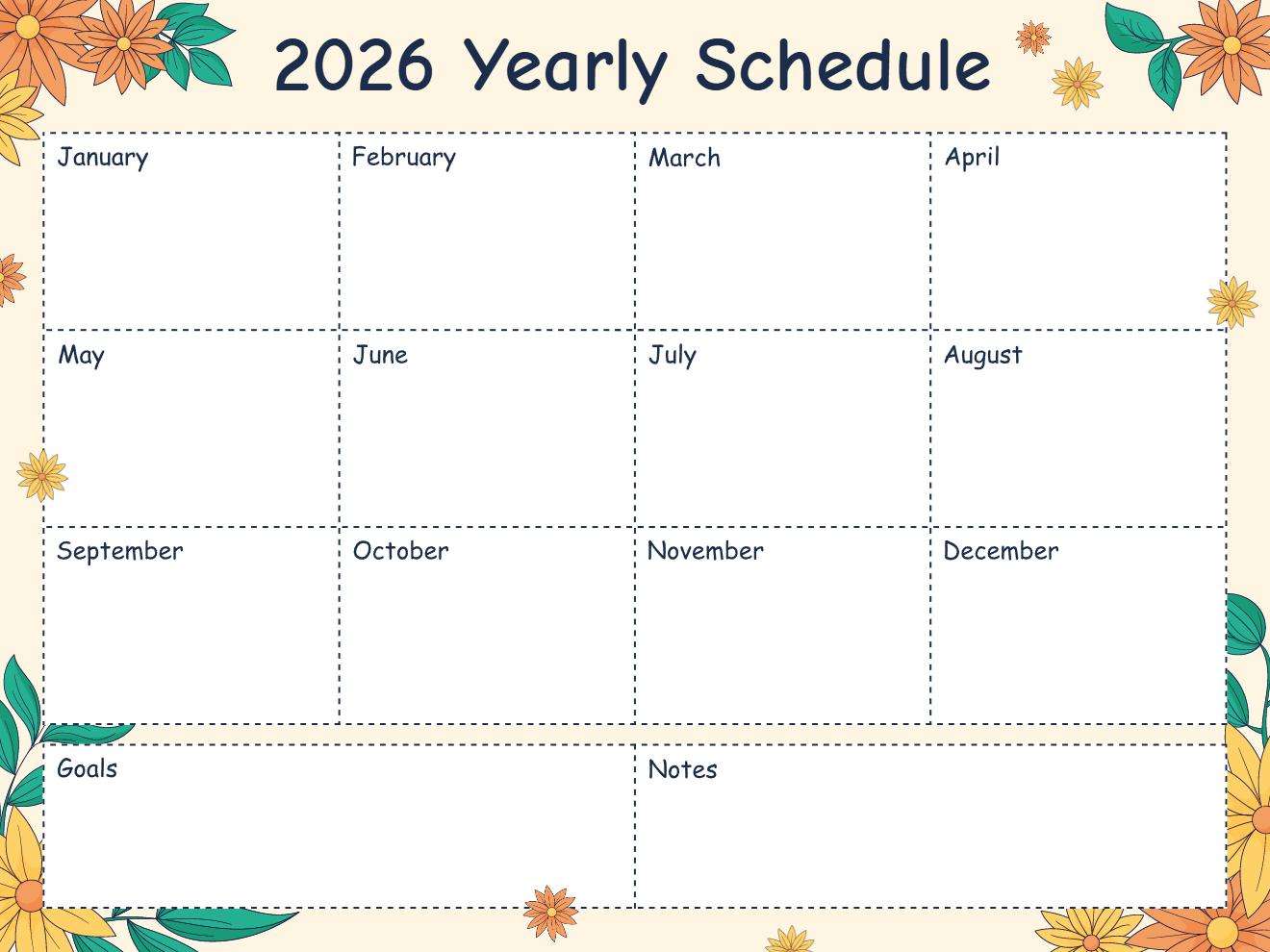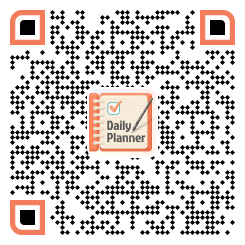The 2026 Yearly Schedule Planner Template is beautifully designed with soft colors and floral elements, making planning a refreshing and inspiring experience. Along with helping you organize tasks, set goals, and keep notes in one place, you can also explore the digital planner app for more customizable layouts that match your style. With its clean design, this template ensures productivity while adding a touch of creativity to your schedule.

Frequently Asked Questions
A yearly schedule planner is a single-page calendar that displays all 12 months at once for high-level annual planning.
It helps you see your entire year at a glance, making it easier to spot busy periods and plan. Unlike monthly planners, a yearly schedule prevents scheduling conflicts by showing the bigger picture. You can track important dates, deadlines, and recurring events without flipping through multiple pages.
This type of planner is best suited for strategic planning, rather than daily task management. It’s ideal for professionals, students, and families who want to coordinate long-term commitments.
Start by marking all known fixed commitments, such as holidays, birthdays, and major deadlines, throughout the year.
Next, add recurring events such as quarterly reviews, seasonal projects, or monthly meetings. Use different colors or symbols to distinguish between work, personal, and family commitments. This visual coding helps you spot imbalances at a glance.
Review your planner weekly to stay aware of upcoming events and adjust priorities as needed. At the start of each month, zoom into that specific section to plan details. The yearly view keeps you strategic, while the monthly schedule planner templates keep you tactical.
The goals section should list 3-5 major objectives you want to achieve throughout the year.
These can be career goals, personal growth targets, or family projects. Break them into quarterly checkpoints to track progress. For detailed tracking, use goal planner templates with your yearly schedule.
The notes section is for quick reminders, ideas, or flexible tasks that don’t have fixed dates yet. Use it for things like “research vacation destinations” or “budget review in Q3.” This keeps your monthly sections clean while capturing important but non-urgent items.
Update your planner immediately when you commit to a new date or deadline to avoid double-booking.
Do a comprehensive monthly review at the start of each month to refresh your memory. During this review, add any new commitments that have come up and cross off completed items. This habit takes 10 minutes but saves hours of confusion later.
Quarterly reviews are also valuable for assessing whether you’re on track with your goals. For breaking down annual objectives into manageable chunks, use quarterly planner templates alongside your yearly overview.
Add industry-specific milestones like conference dates, certification deadlines, or performance review periods to each month.
Color-code work projects to spot busy months easily. Use the goals section for targets like “complete leadership course” or “expand network.” For detailed planning, pair it with business planner templates.
If you manage a team, include project launch dates and team member milestones. The yearly view helps you distribute workload evenly and avoid burnout periods. You can also track vacation days for your team to ensure adequate coverage.
Absolutely mark school holidays, sports seasons, and family birthdays throughout the year for better coordination.
Use the monthly sections to note kids’ extracurricular activities, medical appointments, and school events. The goals section works well for family objectives like “plan summer vacation” or “complete home renovation.” The family planner templates complement the yearly view by adding dedicated space for meal planning and household task management.
Color-coding by family member makes it easy to see everyone’s commitments at once. You’ll quickly spot scheduling conflicts before they happen, making family life smoother. Print multiple copies if needed, one for the fridge and one for your office.
Start with a spreadsheet or design tool and create a 3×4 grid for the 12 months of the year.
Allocate equal space to each month, ensuring each box is large enough to write multiple entries. Add a header with the year and include dedicated sections at the bottom for goals and notes. Use borders or light shading to separate months visually without overwhelming the design.
Export your design as a PDF for printing or keep it as an editable digital file. Test it by adding a few sample entries to ensure the spacing works well. Adjust font sizes and box dimensions based on how much detail you typically track. Some people need more space than others.
The biggest mistake is adding too much detail, which defeats the purpose of a high-level overview.
Yearly planners should show only major events and deadlines, not daily tasks or hourly appointments. Overloading the template makes it cluttered and hard to read at a glance. For detailed task management, use daily planner templates instead.
Another error is failing to review it regularly. A planner only works if you actually look at it. Set a recurring reminder to check your yearly schedule weekly. Also, some people don’t leave buffer time between major commitments, leading to burnout.
Place your planner somewhere highly visible, wall-mounted, or on your desk so you see it daily.
Use consistent symbols or abbreviations across all months to maintain clarity. For example, “BD” for birthdays, “DL” for deadlines, and “V” for vacations. This standardization helps you scan the year without reading every word.
Pair your yearly planner with a detailed monthly or weekly system for task execution. The yearly view handles strategy while shorter-term planners manage tactics. Review past years’ planners to identify patterns in your productivity and adjust future planning accordingly.
It connects abstract goals to specific time blocks, making aspirations actionable and time-bound.
When you assign goals to particular months, you’re forced to think about sequencing and dependencies. For example, if your goal is “launch a side business,” you can map preparation in early months and launch in later months.
The visual reminder of your goals alongside your schedule helps you allocate time realistically. If a month looks packed, you know you can’t add major new projects. This alignment between available time and ambitions is crucial for actually completing what you set out to do.
You can download this template from platforms like Planwiz that offer ready-to-use planner designs.
Look for templates available in multiple formats, PDF for printing, and editable versions for digital use. Most platforms allow immediate download after selection, with no design skills required. Check if the template includes both color and black-and-white versions for printer flexibility.
Both options work depending on your planning style and where you need to access your schedule.
Digital editing allows you to update the planner throughout the year without reprinting. Use PDF editors, note-taking apps, or design software to add text directly onto the template. This approach is eco-friendly and perfect if you work primarily on devices.
Printing works best if you prefer tactile planning or want to display it on a wall or bulletin board. Many people find that physically writing helps with memory retention. You can also print, fill it partially, and scan it back for digital backup, combining both approaches.




